Rice to the occasion: Bold new twists on nasi lemak with familiar tastes
Sign up now: Get ST's newsletters delivered to your inbox

Gen Z foodpreneurs have given their own twist to the local favourite.
PHOTO: SO LEMAK, HEDY KHOO
Follow topic:
SINGAPORE – Nasi lemak bun. Nasi lemak burger. Nasi lemak risotto. The hawker dish has been revamped and is enjoying a resurgence in popularity with new iterations.
The breakfast staple traditionally comes with coconut rice accompanied by ikan bilis, peanuts, sambal and slices of cucumber, sometimes with a fried ikan kuning or chicken wing.
Gen Z foodpreneurs have given their own twist to the local favourite. They include Mr Ernest Ang, 23, who sells twice-cooked coconut rice at Kokoyo Nyonya Delights which opened in August; and Ms Shanice Lim, 27, who opened her second outlet of So Lemak in September.
On the fast-food front, McDonald’s Singapore brought back its Nasi Lemak Burger from February to March.
Taiwanese restaurant and craft beer bar Abundance launched its ode to the dish with a Nasi Lemak Bun on March 13.
Halal-certified Korean fast-casual eatery Jinjja Chicken has reprised its K-Nasi Lemak, which features coconut-infused Korean purple rice and the chain’s signature Korean fried chicken.
At Muslim-owned Malayan Settlement, Nasi Lemak Risotto is made with lemongrass, pandan and coconut cream, with a garnish of sambal and ikan bilis.
Then there are new contenders championing Malaysian-style nasi lemak – which comes with fried chicken leg marinated in a blend of spices, and sambal packed with onion – such as Kitchenman Nasi Lemak in Kallang and hawker stall The Kumpong Boys in Ang Mo Kio.
Like several nasi lemak sellers, Ms Lim credits the likes of The Coconut Club and Dickson Nasi Lemak for elevating the traditional dish with better-quality ingredients and a focus on ambience.
Brands like theirs have propelled nasi lemak to new heights and renewed interest in the humble hawker meal.
She reckons that McDonald’s Nasi Lemak Burger – which sold out in two weeks when it was launched in July 2017 – played a role in paving the way for new iterations.
However, she notes that if the new version of nasi lemak is too radical, it may be difficult for diners to accept.
She says: “For new versions to work, they cannot be too far off from the original. Some elements which have to be present are sambal, ikan bilis, peanuts and coconut flavour, which is the star of the show.”
Nasi Lemak Ayam Taliwang’s chief operating officer and co-founder Noorman Mubarak, 46, welcomes new-fangled versions as they help raise the profile of the original dish. His chain of stalls sells a version which combines nasi lemak with ayam taliwang, an Indonesian dish of spicy grilled chicken.
He agrees new versions need to retain some elements of the original and recalls receiving his fair share of criticism when he started selling his dish.
Diners in their 60s and above said his version was not nasi lemak since it served a chicken leg instead of ikan kuning. Today, such a format has become common, he observes.
“It takes time for people to accept changes. Every traditional dish that we know now was new at the time it was created,” he says.
Local diners love novelty, but also want a sense of familiarity, he adds.
Abundance co-founder Jaz Yew, 43, who created its Nasi Lemak Bun, says: “Some people may not accept new variations of nasi lemak, but there will be chefs who want to innovate. Reworking the dish needs to be well thought out. It is a risk because if it fails, it may even be viewed as an insult to tradition.”
So Lemak: Wood-fired, charcoal-grilled nasi lemak
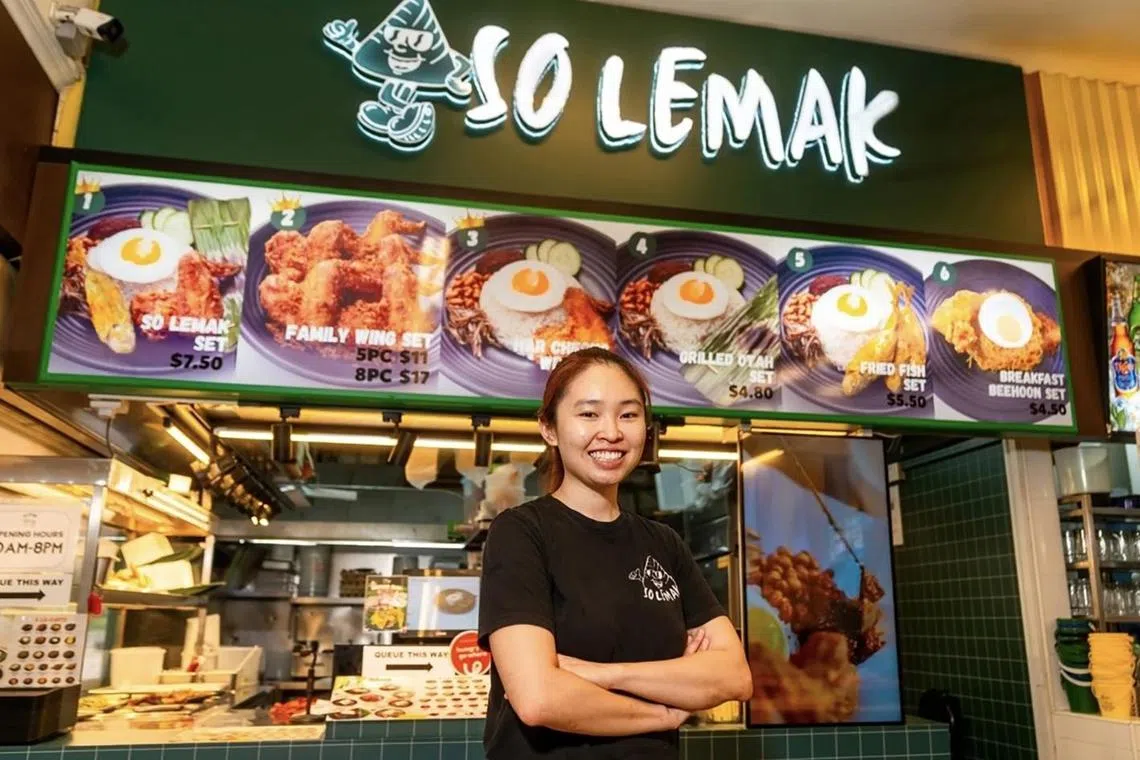
Ms Shanice Lim, owner of So Lemak.
PHOTO: DANIEL ISKANDAR
Where: Stall 7, 01-2823, Block 721 Ang Mo Kio Avenue 8
Open: 10am to 8pm daily
At So Lemak, which has two coffee-shop stalls, owner Shanice Lim, 27, sells nasi lemak paired with her signature har cheong wings.
She launched her first outlet in Bedok North Street 1 in May 2023 and opened her Ang Mo Kio Avenue 8 outlet in September 2024. She operates in coffee shops to keep prices affordable. At both outlets, the rice is cooked in fresh coconut milk for an intense, nutty aroma.
Prices start at $4.80 for the Grilled Otah Set, which comprises otah, a sunny side up egg, ikan bilis, peanuts and coconut rice. The Har Cheong Wing Set costs $5, while the Ayam Berempah Set, which comes with a chicken leg, costs $8.50.
Come May, Ms Lim will be launching premium a la carte dinner items which are grilled over binchotan and lychee wood logs to impart smoky flavours. These will be available only at the Ang Mo Kio outlet.
She notes that customers who pursue trends get bored easily.
“Younger diners and working adults in their 20s to 40s may not be satisfied with the standard nasi lemak. They want premium accompanying dishes in the style of nasi padang. They want variety and choices of protein, from meat to seafood,” she says.
In January, she began developing recipes for her new items, which include Slow Roasted Rendang Beef Cheek, Grilled Seabass With Sambal, Grilled Jumbo River Prawn With Curry And Chilli Oil and Grilled Nasi Lemak.
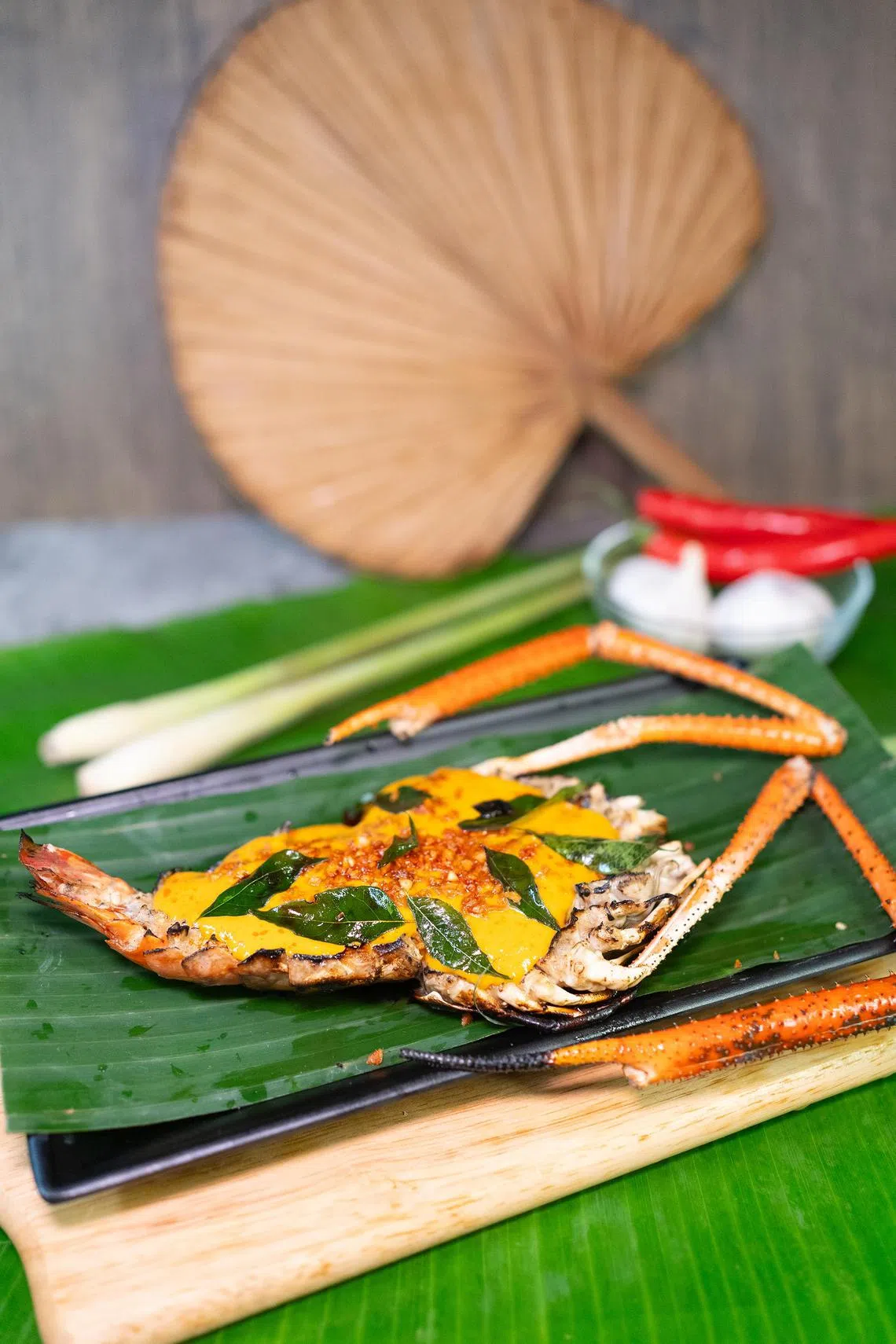
So Lemak will launch its Grilled Jumbo River Prawn With Curry And Chilli Oil in May.
PHOTO: SO LEMAK
For the Grilled Nasi Lemak, coconut rice, ikan bilis, peanuts and sambal are wrapped into a pyramid using banana leaves. The parcels will be grilled to order.
Ms Lim says the new items will likely range from $15 to $30. She adds: “Over time, people have refined their palates and have higher expectations. To them, nasi lemak is no longer a staple. It is a dish to enjoy and savour with premium ingredients.”
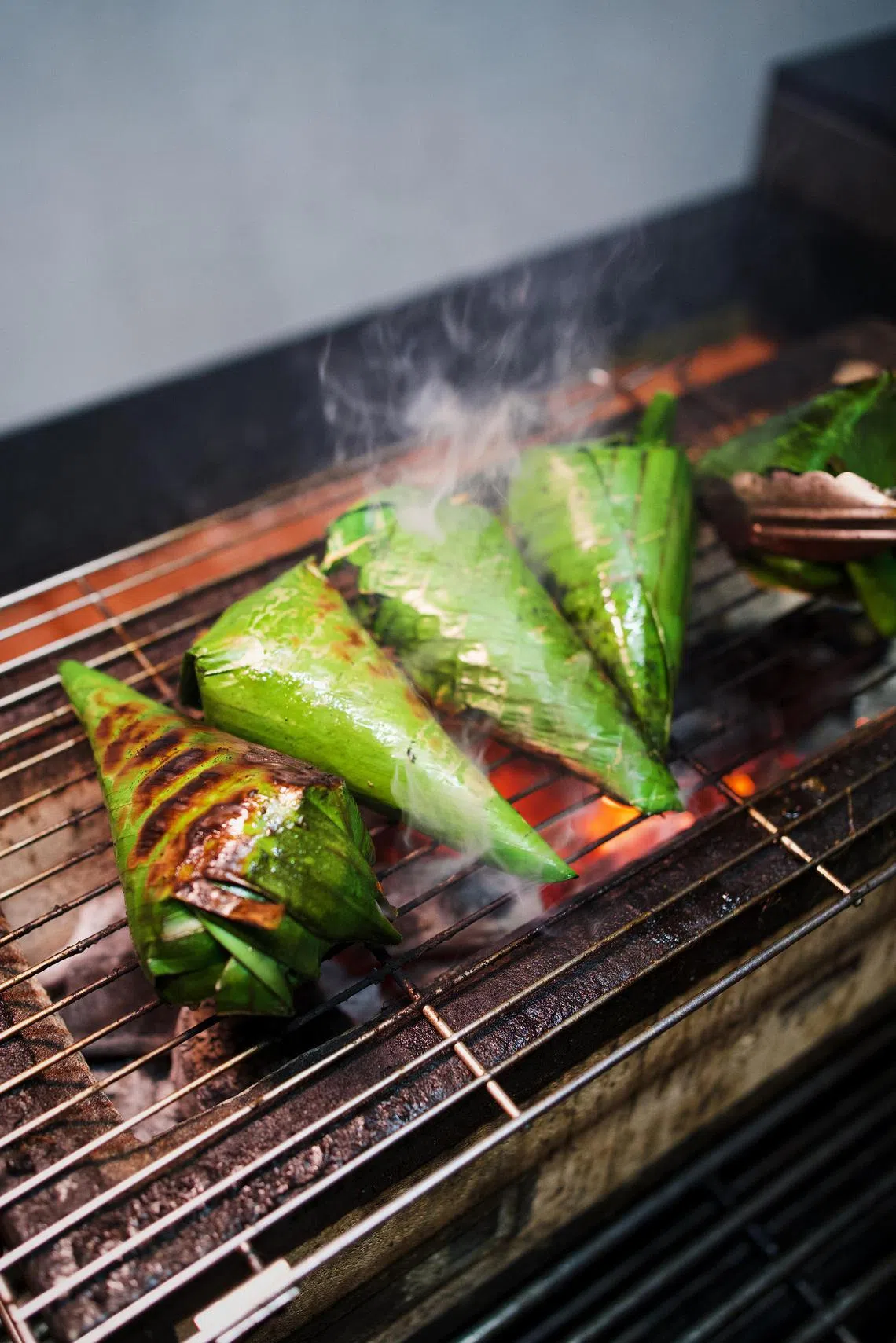
Grilled Nasi Lemak launches in May at So Lemak’s Ang Mo Kio outlet.
PHOTO: SO LEMAK
Abundance: Nasi lemak bun with coconut flakes
Where: Three outlets, including 01-35 Century Square, 2 Tampines Central 5 a8undance.sg
Open: 11am to 10pm daily
Info:
When co-founder Jaz Yew of Taiwanese restaurant and craft beer bar Abundance noted a renewed interest in nasi lemak in 2024, with many versions featuring a fried chicken leg, he decided to come up with one that would be a variation of the restaurant’s signature Gua Bao (braised pork belly bun).
It took two months to perfect the Nasi Lemak Bun ($10.90++) before its launch on March 13.

Taiwanese restaurant and craft beer bar Abundance launched its Nasi Lemak Bun on March 13.
ST PHOTO: HEDY KHOO
Doing away with the coconut rice, Mr Yew tapped on toasted coconut flakes to provide aroma in his rendition.
A fluffy housemade bun holds a slab of turmeric-tinged crispy, fried boneless chicken thigh. Coconut milk is used in the marinade to double the nutty flavour.
A housemade sambal, generously spiked with red and white onions, and ikan bilis complete the dish.
“A lot of people eat nasi lemak and many can cook the dish, so consumers are familiar with it. We were prepared for criticism because it is challenging to take something that people hold close to their hearts and come up with a new format for it. People all have their opinions on what nasi lemak should be,” he says.
But customers are already asking for the bun – available till end-May – to be a permanent item on the menu.
Mr Yew, who is pondering the move with his business partner, says: “We are a Taiwanese restaurant, so we are hesitant to include it on our regular menu. But we also want to take into consideration local diners who enjoy our Nasi Lemak Bun.”
Jinjja Chicken: Nasi lemak with a Korean twist
Where: Jinjja Chicken outlets, including 01-11 Bugis+, 201 Victoria Street; and Jinjja Kitchen, 02-02 Changi Airport Terminal 2, 60 Airport Boulevard jinjjachicken.com
Info:
Halal-certified Korean restaurant chain Jinjja Chicken launched its K-Nasi Lemak for a six-week promotion in April 2024. Even after it ended, customers requested the dish.
Priced at $8.90, the set comprised two Jinjja Wings with a choice of Soy Garlic Sauce or the spicy Yangnyeom Sauce, cucumber muchim (spicy cucumber salad), Korean purple rice cooked in coconut milk, a marinated soft-boiled egg with a jammy yolk, sambal, ikan bilis and peanuts.
In 2025, Jinjja Chicken managing director Bernard Tay, 45, decided to bring back the dish with new options for another six weeks as a Ramadan special. It will be available until end-April at all Jinjja Chicken branches and the Jinjja Kitchen outlet at Changi Airport.
It is still priced at $8.90, and diners can now opt for the set to come with three pieces of K-Boneless Chicken instead, or pay $1 more for one drumstick and two wings.
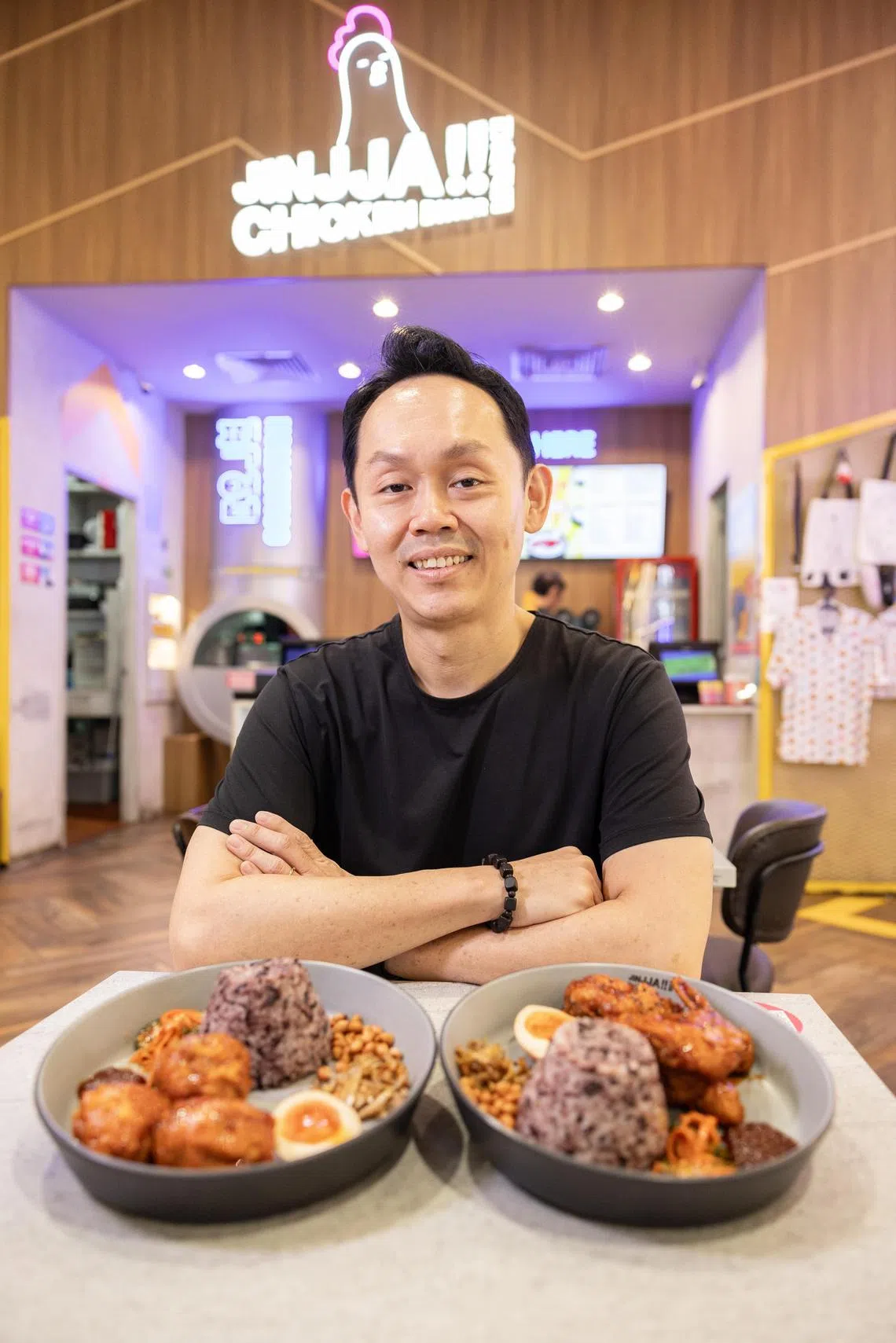
Jinjja Chicken managing director Bernard Tay with two options of the chain’s K-Nasi Lemak.
ST PHOTO: BRIAN TEO
It took three weeks to develop the recipe for the K-Nasi Lemak in 2024.
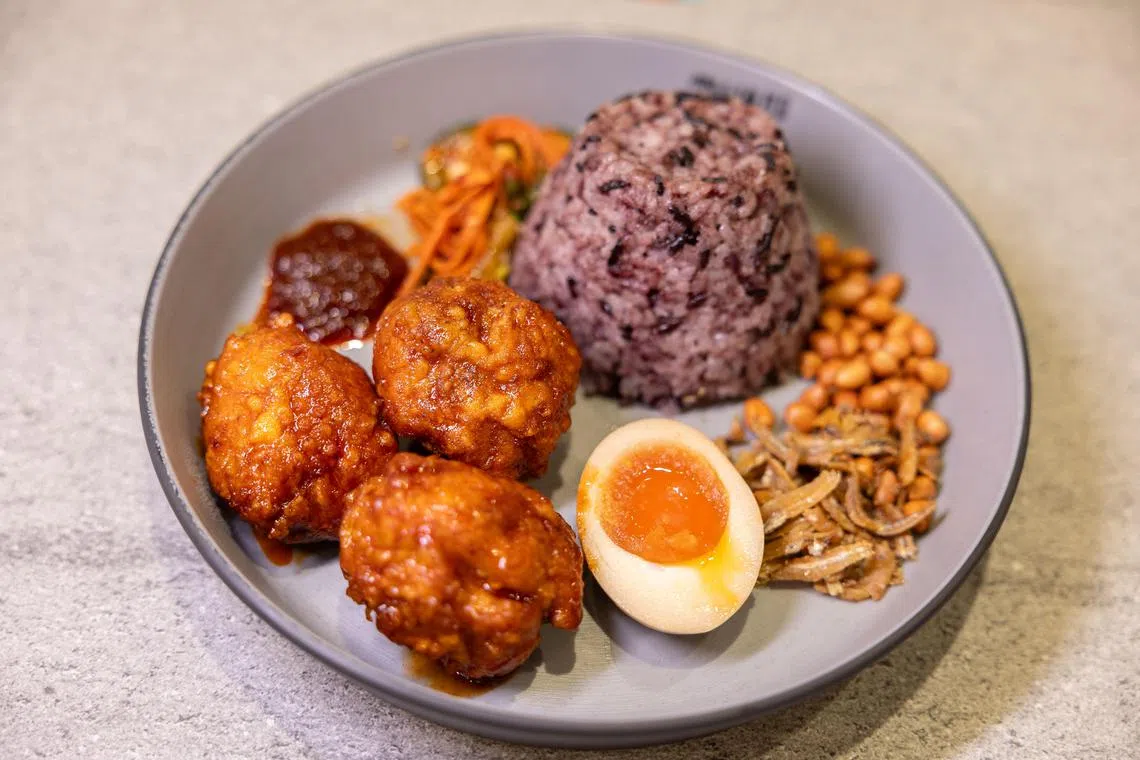
Jinjja Chicken’s K-Nasi Lemak with K-Boneless Chicken.
ST PHOTO: BRIAN TEO
Mr Tay, who has three daughters aged five, 10 and 13, says: “We have to intrigue the younger generation for them to eat nasi lemak. New variations can create sufficient curiosity for them to be interested in the original.”
His daughters, who are not fans of nasi lemak, enjoy eating the K-Nasi Lemak because it has Korean and fast-food elements.
“They find it relatable,” he says. “It is inevitable that nasi lemak has to go through innovation. The fact that people want to come up with new versions of the dish is a testament to its popularity.”
Malayan Settlement: Nasi lemak risotto infused with coconut milk and pandan
Where: 01-03 CQ@Clarke Quay, Block B, 3 River Valley Road
Open: 11am to 11pm (Mondays to Thursdays), 11 to 1am (Fridays), 9 to 1am (Saturdays), 9am to 11pm (Sundays and public holidays)
Tel: 9009-7345
When founder and chief executive Hafiz Alkhatib of The Malayan Council group was planning to launch a new concept, Malayan Settlement, at Clarke Quay in December, he felt the time was ripe to introduce a dish he had imagined some two decades ago.
As a hotel kitchen apprentice learning to cook risotto, he had the idea to marry it with nasi lemak, but it was not until June 2024 that he got round to testing the dish in his home kitchen.
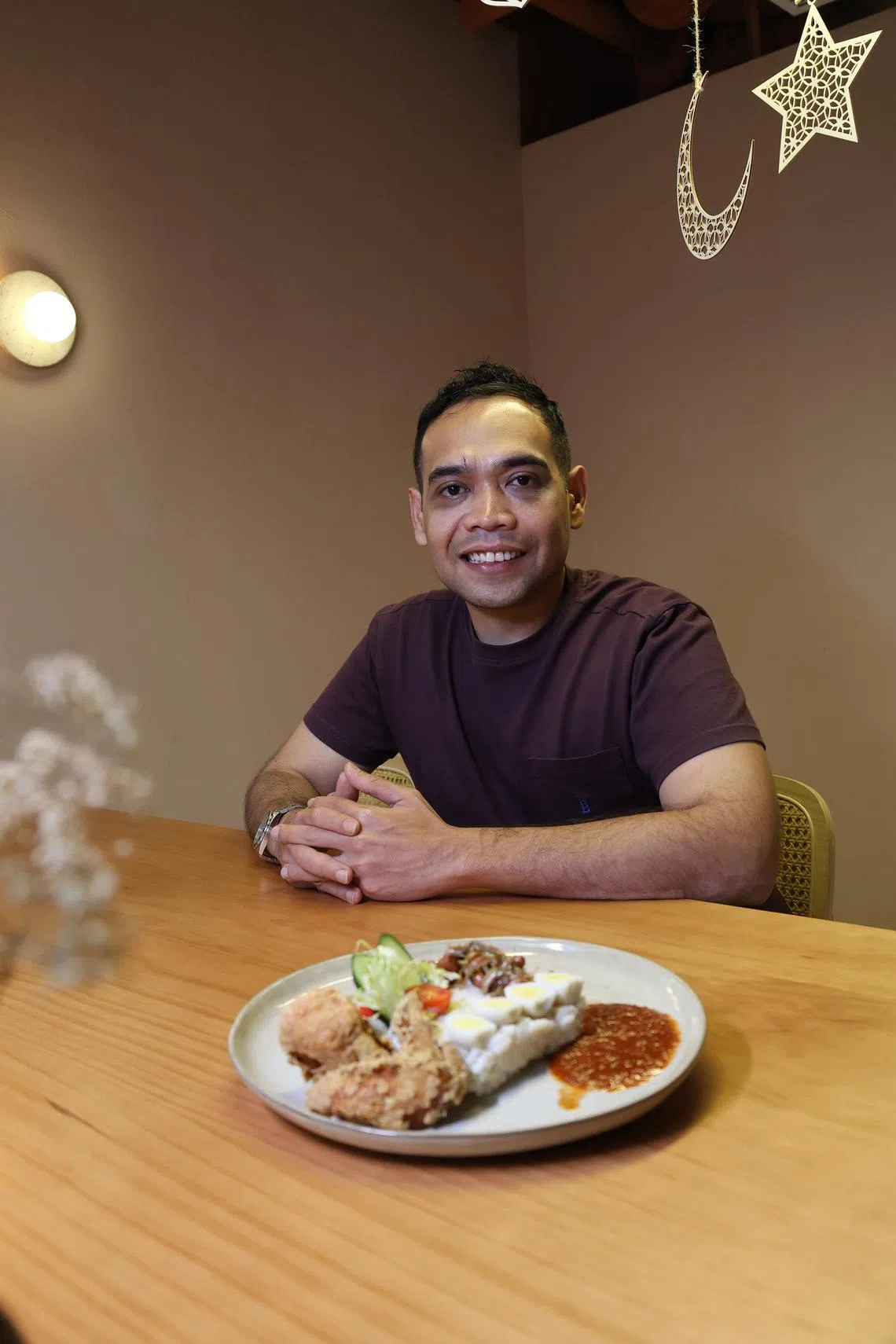
Founder Hafiz Alkhatib of The Malayan Council group with Nasi Lemak Risotto at Malayan Settlement.
ST PHOTO: HEDY KHOO
It took three months to develop the recipe.
Mr Hafiz, 39, felt the dish would be a perfect fit for the new restaurant, which serves Western fare with Asian influences. He says: “It is a make-or-break dish, you either love it or hate it.”
When launched, the coconut milk-infused risotto, priced at $28++ and served simply with ikan bilis, peanuts and sambal, received more criticism than compliments.
Customers commented that it lacked cucumber and fried chicken. Some were confused why nasi lemak was served with “porridge” instead of rice.
Those who liked it enjoyed the familiar taste of coconut and the punchy sambal, made in-house from dried chillies.
In response to feedback, the dish ($32++) now comprises risotto cooked using Italian arborio rice, a fried chicken wing marinated in sambal, two hard-boiled quail eggs, housemade sambal, ikan bilis and peanuts.
The arborio rice is cooked to order using pandan-infused vegetable broth and coconut milk.
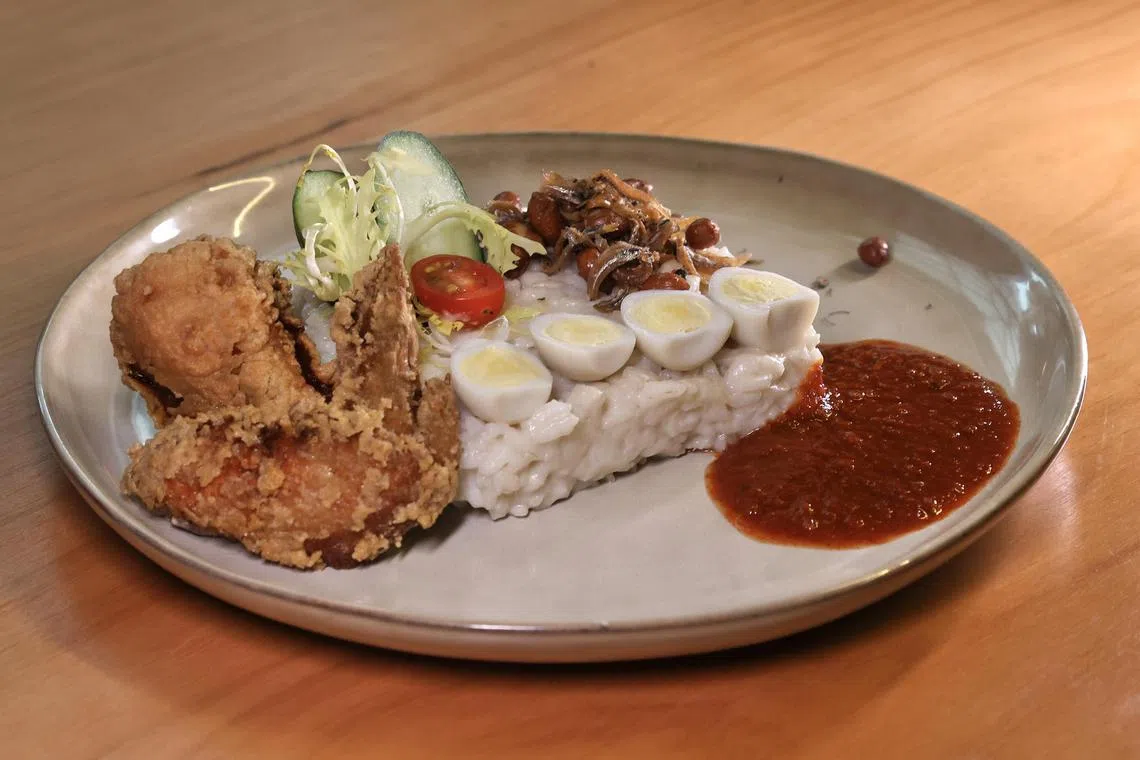
Nasi Lemak Risotto at Malayan Settlement.
ST PHOTO: HEDY KHOO
The vegetable broth allows the kitchen to make the dish vegetarian-friendly if requested.
More tweaks are under way, such as serving the ikan bilis and peanuts on the side, instead of as a garnish, so they remain crisp.
Mr Hafiz does not think he is pushing the limits with his risotto as coming up with Malay-Western dishes is not new to him. He created The Malayan Council’s Classic Ondeh-Ondeh Cake ($10.50++, available at all five The Malayan Council outlets and Malayan Settlement) and Asam Pedas Fish & Chips ($25++, available only at the Dunlop Street and Bussorah Street outlets).
He believes food should be fun, and is prepared to accept criticism for new dishes and find ways to improve.
He says: “The idea is to delight and adapt to the palates of diners. There will be haters, but also supporters, when you come up with a new spin on traditional favourites.”
Kitchenman Nasi Lemak: Return to Malaysian roots
Where: 01-08/13 CT Hub, 2 Kallang Avenue
Open: 11.30am to 9pm (Mondays to Saturdays), closed on Sundays
Kitchenman Nasi Lemak is a partnership between Ipoh-born chef Cheow Kah King, 38; his wife Chong Pui Kuan, 36; and his sister-in-law Chong Pui Ying, 34. It was started in December 2023 out of chef Cheow’s love for the dish and desire to present his own version of high-quality Malaysian-style nasi lemak at pocket-friendly prices.
Six months after opening the 40-seat eatery, his sister-in-law stopped bickering with him over his insistence on using fresh ingredients and has accepted that ingredients make up 40 per cent of their operating costs.
She says: “Our customers are able to tell that our ayam berempah is made using fresh chicken and they prefer it over the frozen chicken used elsewhere.”
The eatery was listed in the Michelin Guide Singapore 2024.

Founder and chef Cheow Kah King of Kitchenman Nasi Lemak with Nasi Lemak Ayam Goreng Berempah Leg and Nasi Lemak Kam Heong Chicken.
ST PHOTO: HEDY KHOO
The star dish at Kitchenman Nasi Lemak is Nasi Lemak Ayam Goreng Berempah Leg ($13.80). Fresh coconut milk and fresh Thai ginger go into making the glossy coconut rice, which is mild in flavour to balance the heavier flavours of the sambal and ayam berempah. Fresh chicken legs are marinated for five hours in a spice paste prepared from scratch.

Nasi Lemak Ayam Goreng Berempah Leg at Kitchenman Nasi Lemak.
ST PHOTO: HEDY KHOO
Chef Cheow insists on using fresh coconut milk, which costs a premium, as he is inspired by kampung-style nasi lemak, which relies on fresh ingredients. He says: “I want young people to have a taste of old-school nasi lemak.”
His sambal takes five hours to make, to allow the red onions to caramelise.
Nasi Lemak Kam Heong Chicken ($15.80) is the latest set, launched on March 31.
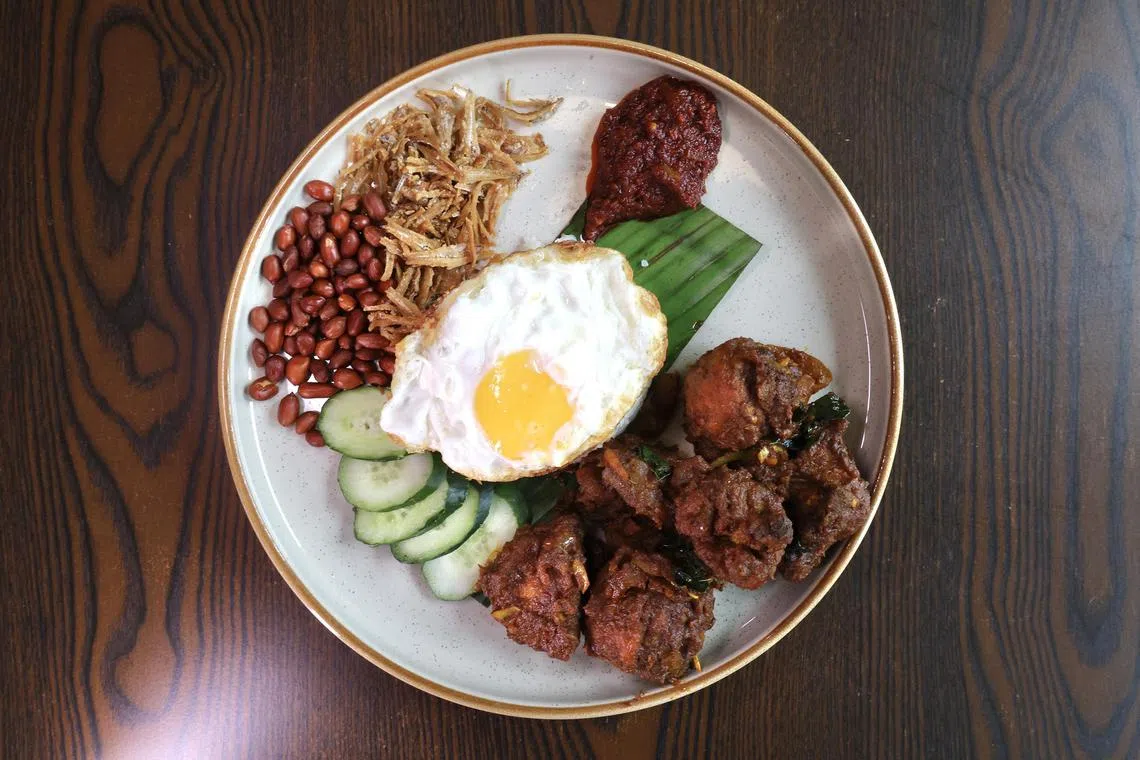
Nasi Lemak Kam Heong Chicken at Kitchenman Nasi Lemak.
ST PHOTO: HEDY KHOO
Fresh chicken leg is cut into six bite-sized pieces and marinated in a blend of ingredients including curry powder. Chef Cheow chose kam heong chicken to go with his nasi lemak because he feels it reflects the multicultural aspects of Malaysian cuisine, with its use of curry leaves and curry powder.
The addition is to keep things fresh for customers.
While other sellers are coming up with new versions of nasi lemak, chef Cheow wants to fly the flag for Malaysian-style nasi lemak with side dishes that he cooks to order.
He says: “Ours is a family-friendly establishment as I hope young children can be introduced to this style of nasi lemak and learn to enjoy it.”
The Kumpong Boys: Singaporean cooking Malaysian-style nasi lemak
Where: Stall 6, 01-06 The Daily Inn, 226F Ang Mo Kio Avenue 1
Open: 10am to 8pm (Wednesdays to Mondays), closed on Tuesdays
Tel: 9010-3133
With zero culinary knowledge, Mr Jonas Koh, 30, paid a former colleague, a Malaysian head chef, $10,000 to teach him to cook Malaysian-style nasi lemak and help him set up a stall.

The Kumpong Boys stall owner Jonas Koh with the Berempah Set and Curry Ayam Set.
ST PHOTO: HEDY KHOO
In early September, he plunged into the deep end, opening The Kumpong Boys at a coffee shop in Ang Mo Kio Avenue 1.
At his stall, the popular items are the Berempah Set ($6.90) and Curry Ayam Set ($6.90).
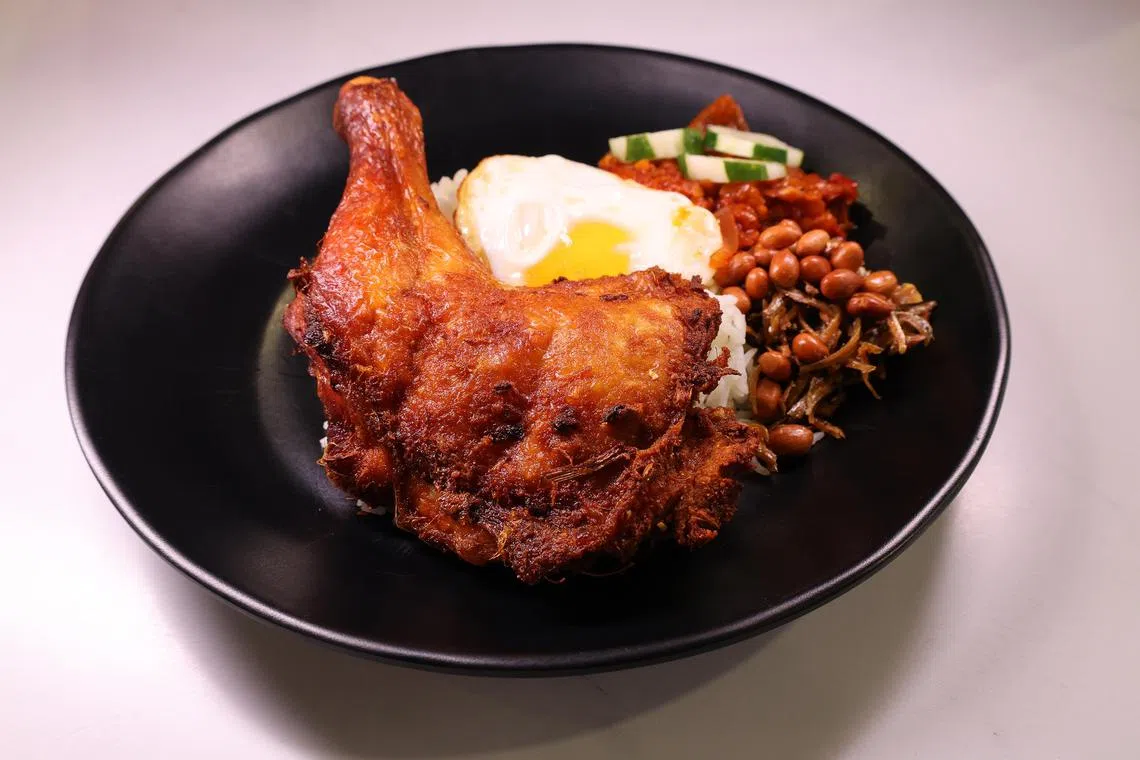
Berempah Set at The Kumpong Boys in Ang Mo Kio.
ST PHOTO: HEDY KHOO
To keep his work process simple, Mr Koh’s chicken berempah does not come with crispy bits of fried spices.
Frozen chicken legs are brined for up to 12 hours to keep them juicy. He prepares the spice paste from scratch, using lemongrass, fresh ginger, shallot and garlic.
Instead of using Thai jasmine rice as taught, Mr Koh switched to basmati rice as it is a healthier carbohydrate.
He had met the chef while working as a bartender at an American restaurant from 2021 to 2022, and kept in touch with him even after becoming a restaurant manager for a food and beverage company. He quit in November 2023 and took a break before opening his stall.
The head chef had cooked the Malaysian-style nasi lemak with chicken berempah for staff meals a few times at the American restaurant.
“It was a memorable meal which everyone loved and talked about, from the sous chef to the servers,” says Mr Koh.
The berempah chicken was very different from the usual fried chicken wing in nasi lemak here.
“The flavours of spices were fully incorporated into the chicken. The caramelised red onion in the sambal lifted the dish.”
Initially, the two men discussed being business partners, but changed plans as the head chef wanted to start the business in Malaysia, while Mr Koh wanted to remain in Singapore.
The chef offered to give him a crash course in cooking Malaysian-style nasi lemak and help set up the stall.
Mr Koh flew to Kuala Lumpur in June 2023 for two weeks, during which he learnt to prepare the coconut rice and chicken berempah. The chef also took him to try some well-known nasi lemak joints, including Village Park Restaurant in Petaling Jaya.
Mr Koh chose to sell Malaysian-style nasi lemak as he observed a growing demand for it in Singapore.
He says: “Ultimately, nasi lemak is a traditional dish in both Singapore and Malaysia, and it is something most Singaporeans enjoy eating.”
While he finds the trend for newfangled versions of nasi lemak has stirred up interest in the dish, he prefers the traditional style.
He notes: “My version is back-to-basics. I focus on the rice and sambal, and have not deviated much from Malaysian-style nasi lemak, which shares common elements with the nasi lemak Singaporeans have grown up with.”
Hedy Khoo is senior correspondent at The Straits Times. She covers food-related news, from reviews to human interest stories.


